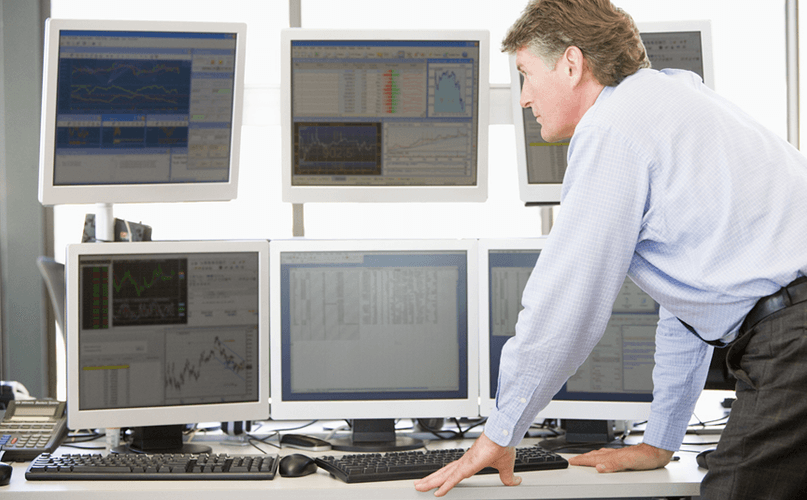Why Use Forex Trading?
To put it simply, foreign exchange trading, or forex trading, involves selling one currency and buying another. For example, if the dollar is losing value in relation to the yen, traders would sell dollars and buy yen. The forex trading strategy would be to then buy back dollars to make a profit.
Forex trading strategies are similar to those used by stock market traders. The same idea of buying low and selling high can lead to profit, but there is also a similar risk involved. As Investopedia notes, exchange rates are constantly changing due to factors like tourism, trade, and even public opinion of an area. When learning how to trade forex, you’ll begin to predict how these factors will change, how the changes will affect exchange rates, and what risk you’ll be taking when making trades.
For many, the risk is worth it. As with any investment or trading opportunity, the more money you have to put into the system as capital, the more you could gain—or lose. The Wall Street Journal says that foreign exchange involves $4 trillion being traded each day, making it the largest financial market. That number is enough to put dollar signs in the eyes of many individuals who are willing to gamble with the risky industry.
See Also: Top Long-Term Investments – Detailed Overview
Learn to Trade Forex – Getting Started



Image source: Bigstock
With such huge numbers, jumping into the trading game can be intimidating. While forex trading education can get complex, it’s absolutely possible to learn the basics and start participating before digging into complicated research and strategies.
As you start learning about how to trade forex, there are eight major currencies that you’ll want to pay attention to, according to Investopedia.
- United States (USD)
- Europe (specifically countries using the Euro – EUR)
- Japan (JPY)
- United Kingdom (GBP)
- Switzerland (CHF)
- Canada (CAD)
- Australia (AUD)
- New Zealand (NZD)
Because every forex trade involves buying one currency and selling another, forex trading strategies are based on currency pairs. The Essentials of Trading, a website with resources for those interested in learning about the market, lists the most frequently traded currency pairs globally as well:
- Euro & U.S. Dollar (EUR/USD)
- U.S. Dollar & Japanese Yen (USD/JPY)
- British Pound & U.S. Dollar (GBP/USD)
- Australian Dollar & U.S. Dollar (AUD/USD)
- U.S. Dollar & Swiss Franc (USD/CHF)
- U.S. Dollar & Canadian Dollar (USD/CAD)
- Euro & Japanese Yen (EUR/JPY)
- Euro & British Pound (EUR/GBP)
With each currency pair will be a price quote, as explained by forex.com. In a price quote, the first currency listed is the base currency, and that base currency has a value of 1. The US Dollar is most frequently used as the base currency and forex trading systems will reflect that. When the base currency is not the dollar, the pair is called cross currencies.
When the quote rises above 1, it means that the base currency has increased in value while the other currency has gotten weaker. If the number is below 1, the base currency has weakened while the other currency has gotten stronger. The numbers change in increments called pips, the number at the fourth place, known as the ten-thousandths place, after the decimal. In a quote, the bid shows the price for selling the base currency while the ask shows the price for buying the base currency.
Don’t Miss: Investment Advisor Search – Top Investment Companies
How to Trade Forex
After learning what the numbers mean, it’s time to get started. Part of getting a forex trading education is to start working with the numbers. However, as an article from Admiral Markets explains, many people jump into trading before they’re ready, which can lead to losing a lot of money in a very short period of time.
There are plenty of trading resources, like forex.com and Admiral Markets, that offer tutorials and webinars to provide details of every aspect of forex trading systems and strategies. While working your way through the lessons, you can apply what you learn to real life scenarios through a demo account. The process will help you learn to trade forex successfully and hone your trading skills before putting your real money on the line.
After you’ve tested the waters with a practice account, you can open an account with a broker. A guide from Investopedia outlines how to choose a reputable broker. The article recommends looking at five factors.
- Be sure the broker is registered with the U.S Commodity Futures Trading Commission, as well as being a member of the National Futures Association.
- Find a broker that offers an account that works well for the level of trading you want to do and the amount of money you’re willing to put into trading.
- The broker should offer the currency pairs that you’re interested in.
- Ask about aspects of the broker’s customer service. Find out how long you’ll have to wait to talk to a representative, how they prefer to communicate, and whether you’ll have access to assistance when you’ll need it.
- Find a broker that offers your preferred forex trading platform. The platform should be well-designed and easy to use. You don’t want to suffer from an error on the platform that could be easily avoided with a better design.
All-in-One Change Management Tools
Top Rated Toolkit for Change Managers.
Get Your Change Management Tool Today...
Forex Trading Software
Normally, forex trading platforms are either locally-based or web-based. The platform you choose is largely based on personal preference. A good platform will allow you to keep up with news in real time, track trades, use charting tools, and analyze data.
The forex trading strategies described by experts are complicated and can be difficult for traders of any skill level. When the market moves so quickly, staying on top of changes and being ready to react quickly is the key to success. Luckily for tech savvy individuals in the industry, there is an extensive list of forex trading software options. Using apps makes it possible to learn, research, and trade from anywhere with a mobile device.
- Forex.com has a mobile app that allows users to customize many of the features in a way that works best for their needs. Tools like real time news, charting, and full trading abilities make it useful and easy to work with.
- Pepperstone features a clean and simple interface that makes the app easy to use. Live quotes allow you to stay up-to-date on the numbers, while trading features give a full range of services, even on a small smartphone screen.
- Trade Interceptor was designed for serious traders. The forex trading software has all of the features of the desktop software and stands out for its tools to analyze data.
- Staying up to date with the news is the best way to be on top of your trading game. The Bloomberg mobile apps offer reliable information, updated in real time.
- XE Currency is another must-have app. The app keeps currency rates updated and allows for quick currency conversions to help you make informed decisions.
Related: Best Asset Management Firms | Best Asset Managers
Forex Trading Strategies
The difference between being successful with foreign exchange trading and failing is whether you start with a solid plan. You won’t have all of the knowledge or skill as a beginner, but you can create a plan based on the forex trading education you acquire before opening your account.
FX Market Leaders offers a wealth of information for trading beginners, including a guide to building forex trading strategies. FX Market Leaders suggests starting by determining how much money you have available and how much you’re willing to put into your trade. Choosing a conservative amount of 2 or 3% per trade will allow you to grow your profit steadily, without risking huge losses if a trade is unsuccessful.
Forex trading strategies, while designed to help you make the largest possible profit from your trades, should also help you decide when it’s time to stop. According to Daily FX, traders can set a stop-loss order which ends trading when the rate drops below a pre-determined number of pips.
As you learn more about how to trade forex and get some practice with buying and selling, you can search for trends that will help you further develop your forex trading strategies. As FX Market Leaders mentions, noticing a trend may be easy, but as many uncertain factors come into play, you’ll need to be ready to take action quickly.
Scalping is a great example of this fast paced way of trading. According to FX Market Leaders, scalping is a forex trading strategy that involves making many quick, short-term trades. This strategy is low risk because the amount of money involved in each trade is small. However, if the trades are successful, those small profits can quickly add up. Scalping can be completed quickly and requires sharp decision-making skills.
According to Admiral Markets, automated forex trading is a strategy that basically eliminates the need to have a strategy. When using automated forex trading systems, experts create algorithms that analyze trends and perform trades based on the data. The systems reduce risk, save time, and take emotion out of the equation. However, for those looking for a large profit, automated forex trading may not be the best option.
Popular Article: eToro Review – Review and Ranking (eToro Fees, App, Trading, Account, and Services)
Can Forex Trading Be a Full Time Job?



Image source: Bigstock
With big risk can potentially come big rewards, but can the dream become a reality? Many people decide to learn to trade forex as a side job in addition to their full-time job, to add to their income, or in hopes of earning enough to focus only on trading. A major draw of the industry is that trading doesn’t need to be as time consuming or difficult as a full-time job if done well. Answer the following questions to help you decide if you have what it takes.
- How much money are you starting with? In order to enjoy big profits, you’ll need to start with a lot of capital. Forex trading strategies can help you make gains, but the more money you start with, the easier it will be to see that number grow.
- How much time are you willing to put into it? A post from Daily FX notes that success most likely won’t be quick or easy. Some strategies, like scalping, are fast-paced, but end with small profits. Those strategies that yield large profits usually take much longer.
- Are your goals realistic? Of course, we’d all like to turn $1,000 into $1 million overnight. Unfortunately, that’s not realistic for the vast majority of those who want to learn to trade forex. On the other hand, if you have realistic goals, timelines, and expectations, the rewards can be great.
Learning how to trade forex isn’t for everyone. The industry involves a great amount of risk, stress, and quick decision-making. However, if you can use forex trading strategies wisely, balance risk and reward, and take time to hone your skills, you could be another trading success story.
Read More: What Is a Timeshare? Overview of Buying and Selling Timeshares
AdvisoryHQ (AHQ) Disclaimer:
Reasonable efforts have been made by AdvisoryHQ to present accurate information, however all info is presented without warranty. Review AdvisoryHQ’s Terms for details. Also review each firm’s site for the most updated data, rates and info.
Note: Firms and products, including the one(s) reviewed above, may be AdvisoryHQ's affiliates. Click to view AdvisoryHQ's advertiser disclosures.





